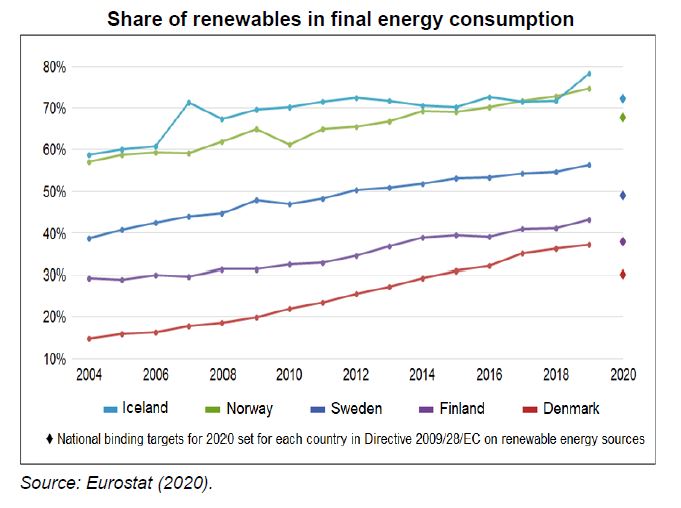Climate Strategies in the Nordic Countries
The Nordic countries (Denmark, Finland, Iceland, Norway and Sweden) have implemented innovative decarbonisation strategies. Pioneers in green public policies (carbon tax since 1990, support measures for low-income households, targeted support for industry, sustainable finance), they now have the four most advanced energy transitions in Europe. They are at the "technological frontier" in terms of integrating renewable energies into their economies.
The Nordic countries (Denmark, Finland, Iceland, Norway and Sweden) are witnessing climate change first-hand, having recorded an increase of 10°C since the preindustrial period in the average annual temperature of some areas, due to the phenomenon known as polar amplification. The increase is more than five times higher than the Paris Agreement goal of limiting global warming to well below 2°C.
In response to the climate crisis, the Nordic countries have developed carbon-cutting strategies that are both innovative and effective, as evidenced by the net decline in the share of fossil fuels in the region's energy mix over the past 15 years. The primary indicators show that since 2005, the Nordic countries have made significantly more progress in their energy transition than most European Union (EU) Member States, and have done so more quickly. Renewables now account for the majority of final energy consumption in the Nordic region.
These positive results stem from the decision of governments, in liaison with economic stakeholders, to introduce much more ambitious climate targets than those set by the EU, and to do so very early on. Carbon neutrality was adopted by some Nordic countries more than a decade before the EU. The economic tools introduced to achieve these targets (record high carbon taxes, innovative bioenergy incentives) and the accompanying support measures put in place to ensure a just transition (income tax cuts for low-income households, targeted subsidies) are central to the Nordic model for a green transition. Green finance is another tool used by the Nordic countries (ending fossil fuel export subsidies, record share of green bonds in the bond market). They have also introduced new export-oriented industrial strategies that leverage the strengths of domestic renewable energy sources. These public policies have transformed the Nordic countries into "laboratories" operating at the technological frontier. No other country in the world has more wind power in its electricity mix than Denmark, more electric vehicles than Norway in terms of market share or more extensive use of bioenergy than Sweden.
These excellent results are tempered by a few things: the lack of a correlation between energy transition and carbon footprint in Iceland and Norway (where the rise in renewable energy has not led to a decrease in emissions), a worrying development of carbon-intensive imports, the environmental impacts of bioenergy (palm oil) and Norway's plans for further oil exploration.
